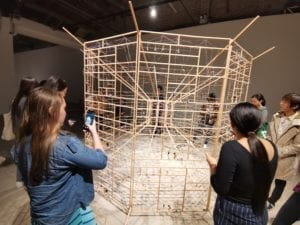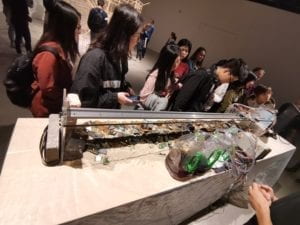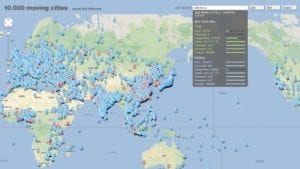Final Project Step 1-Preparatory Research and Analysis-Lifan Yu
A.Experience in Chronus exhibition and Comparing this to other non-technology based artwok:
- “Rechnender Raum (Computing Space)”

A project that really interested me was the “Rechnender Raum (Computing Space)”. It’s made of wood slats, strings, servo motors and lead weights. It is a “full functional logic exact neural network”. I saw the lead weights moving up and down in some logical patterns, controlled by servo motors–the same kind of motors we used in class and in our mid-term project.
The outside part, where all the lead weights are attached, shows the inner process of computing. This is an obvious and simplified way of presenting to us the usually invisible logic behind computing results. Walking around, I can get a brief idea of how computing processes work.
The center part is a polyhedron that changes shape. Strings that are attached to lead weights pull it in different directions. The “pulling” of strings is a result of the previous movements of lead weights (previous computing process). Therefore, the changes in the polyhedron’s shape are results of computing. The inside part displays the final results.
This work attracts me because it turns the machine inside out and gave us a unique perspective of computing. It shows the inner patterns of computing in a visualized, simplified and artistic way. Observing how the lead weights were moving and how they influenced the movements of strings that resulted in changing the shape of the polyhedron is an inspiring experience.
Looking at it, I came understood that tiny, simple units can contribute to macroscopic, complex changes. Simple, repetitive and almost tedious-looking processes (such as the lead weights moving up and down again and again), when connected with each other within a certain logic, can create amazing output (such as the polyhedron’s artistic changes in shape).
2.“Test Execution Host(Turing Machine)”

This device adapted the concept and principles of the Turing Machine. I saw a small device dropping colored liquid (represents 1) and water (represents 0) on sand, rocks and Arduino boards. The device detects the “0”s and “1”s as it moves along a track, computing and deciding on its next movement based on the liquid drops on the sand. We can see the more abstract computing process on a computer screen placed beside the whole device. The device itself is a materialized mimicry of Turing Machine. As is said in it’s introduction “a loss of digital identity and a kind of washing of encoded elements which flips them to the purely physical”.
It is lifeless but also showing human’s way of computing. Although I didn’t quite understand its introduction, it gave me an impression of “when all the complex form of accurate, high-tech components are not taken into consideration, what the most primitive form of mathematical computing looks like”.
3.“Beholding the Big Bang”
A series of gears connected to each other, a latter gear rotates at a slower speed than its former gear. The last gear is almost impossible to rotate. It will only rotate once after 13.82 years.
This piece of artwork displays the extension of time. Looking at the quickly rotating gear at one end and the gear at the other end, I can feel this device conveying a sense of infinity with limited numbers of parts. When numbers increase in exponent form, they really have amazing power.
Non-technological artwork can also convey incisive thoughts that align with technology as discussed above. However, they are displaying these using more traditional methods, instead of using technology itself. They use images, sculptures etc. as carriers of what the artists wish to express.
As for technological artwork, an inner logic based on computing (done by computers, machines etc.) is added. Their structures including circuits, computers, sensors, motors etc. grant the artwork with motions, reactions. Interactions and even artificial intelligence.
Compared to non-technological artwork, technological artwork requires electricity, computing devices and circuits to keep them running. They are a new form of art.
Non-technological artwork only contain art, while technological artwork contains two parts that influence each other—technology and art. Technology provide art with a scientific basis. Art gives technology a vivid and visualized appearance. Their combination is attractive.
B.other interactive projects:
- The project that inspired me: 10.000 Moving Cities – Same but Different, real cubes (Interactive Net-Based Installation)

http://marclee.io/en/10-000-moving-cities-same-but-different/
Visitors can select any city or place, using a digital interface. About the chosen place, the Internet is searched in real time for latest text, image, video and sound information. Four projectors and eight audio speakers project the results into the space. Visitors are able to walk through the model and experience the information in 3D.
The reason why it is so successful is that the video and audio information collected are up to date and real. They allow information collected in a distant land reappear vividly. The information is user-oriented. The 3D display of the images immerse user in the theme “places without a local identity” which. This experience is entertaining, eye-opening and educational. We hope to build devices like this—devices that not only provide people with visual and auditory amazements but also broaden their horizons.
2.A project that I think is less successful: Mini Residency in Kassel-Ocean Waves
The real-time sound of the road traffic ingresses through the basement window and is combined with the projected video “Ocean Waves”. Road noise is transformed to the sound of ocean waves.
This project merely presents information that it collected to audiences. The interactive level between the device and the audience is low. Visually, it is pretty, with a video of beautiful ocean waves. But transforming sounds of traffic to sounds of ocean waves doesn’t have a profound meaning. It won’t attract people’s interest for long. I wish to build a device that can call for certain actions, or push people to think about some contemporary issues carefully and have long-term attraction to its audience.
C. My definition of interaction:
At first, my definition of interaction is simply based on the first reading I had done—” interaction is a cyclic process in which two actors alternately listen, think, and speak”.( Crawford)
We made a reactive project rather than an interactive one in our group work. So I stressed the “two-way” feedback in my definition: Interaction is the process in which two people, devices, or a people and a device communicating with one another. This type of communication should include receiving information, processing the received information and giving a feedback, response or creating a certain kind of action according to the analytical results made in the processing stage. to distinguish interaction from reaction, both of the two interacting units should go through these three processes mentioned. They are both actively engaged in a rather continuous communication. Two-way feedback is indispensable.
A project I researched also helped me distinguish reaction from interaction. Reactive Sparks by Markus Lerner. https://www.markuslerner.com/gallery/reactive-sparks/
This is an installation of seven double-sided vertical screens that is currently in front of the OSRAM main office in Munich, Germany. When cars pass the road in front of the screens, light-colored lines will appear on the screen. Meanwhile, the orange-color waves on the screen rise when the numbers of passing cars increase. There isn’t much interaction between the cars and the device.
Now, after midterm project, my new definition is: the process of an actor (a device, a person, an animal etc.) constantly communicating with the other “actor”. That is, it can detect the information of the other “actor” constantly. The other actor can also respond to the device’s movements, sounds etc. This type of communication can last for a long time instead of ending after a few simple movements.